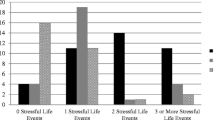Abstract
Strong psychosocial stress is considered to be a precipitating factor in acute coronary events. To assess the hypothesis that the incidence of acute myocardial infarction (AMI) and its severity was remarkably heightened after the great earthquake, we retrospectively analyzed the clinical data of patients with AMI admitted to our hospital during a 3-week period between March 11 and March 31, 2011 (disaster group) as compared with AMI patients during the corresponding time period of 2010 (non-disaster group). The number of patients with AMI in the disaster group increased by about threefold (22 in the disaster group vs. seven in the non-disaster group). Compared with the previous years 2010 or 2009, the odds ratios [OR] for AMI during a 3-week period in 2011 were 4.40 (95 % confidence interval [CI]: 1.05–18.35), 5.66 (95 % CI: 1.42–22.59), respectively. Although the number of patients who underwent coronary revascularization was higher in the disaster group than in the non-disaster group (68.2 vs. 42.9 %, p = 0.0397), peak serum creatine kinase (CK)-MB level was significantly higher in the disaster group than in the non-disaster group (208.0 ± 159.0 vs. 149.3 ± 102.7 IU/l, p = 0.0431). In the disaster group, four patients died of cardiac causes, whereas no patient died in the non-disaster group (in-hospital mortality rate in the disaster vs. non-disaster group: 18.2 vs. 0 %, p = 0.0281). These results suggest that patients with AMI after the earthquake might be subject to strong psychosocial stress, and that psychological stress brought on by such disaster could trigger cardiac events and cardiac death.


Similar content being viewed by others
References
Simons M, Minson SE, Sladen A, Ortega F, Jiang J, Owen SE, Meng L, Ampuero JP, Wei S, Chu R, Helmberger DV, Kanamori H, Hetland E, Moore AW, Webb FH (2011) The 2011 magnitude 9.0 Tohoku-Oki earthquake: mosaicking the megathrust from seconds to centuries. Science 332:1421–1425
Kloner RA, Leor J, Poole WK, Perritt R (1997) Population-based analysis of the effect of the Northridge earthquake on cardiac death in Los Angeles County, California. J Am Coll Cardiol 30:1174–1180
Kario K, Matsuo T, Kobayashi H, Yamamoto A, Shimada K (1997) Earthquake-induced potentiation of acute risk factors in hypertensive elderly patients: possible triggers of cardiovascular events after a major earthquake. J Am Coll Cardiol 29:926–933
Trichopoulos D, Katsouyanni K, Zavitsanos X, Tzonou A, Dalla-Vorgia P (1983) Psychological stress and fatal heart attack: the Athens (1981) earthquake natural experiment. Lancet 1(8322):441–444
Katsouyanni K, Kogevinas M, Trichopoulos D (1986) Earthquake-related stress and cardiac mortality. Int J Epidemiol 15(3):326–330
Scientists of the US Geological Survey and the Southern California Earthquake Center (1994) The magnitude 6.7 Northridge, California, Earthquake of 17 January 1994. Science 266(5184):389–397
Suzuki S, Sakamoto S, Miki T, Matsuo T (1995) Hanshin-Awaji earthquake and acute myocardial infarction. Lancet 345(8955):981
Shiraishi J, Kohno Y, Sawada T, Hashimoto S, Ito D, Kimura M, Matsui A, Yokoi H, Arihara M, Irie H, Hyogo M, Shima T, Nakamura T, Matoba S, Yamada H, Matsumuro A, Shirayama T, Kitamura M, Furukawa K, Matsubara H (2012) Prognostic impact of pulse pressure at admission on in-hospital outcome after primary percutaneous coronary intervention for acute myocardial infarction. Heart Vessels. doi:10.1007/s00380-012-0277-y
Nishizaki F, Tomita H, Yokoyama H, Higuma T, Abe N, Suzuki A, Endo T, Tateyama S, Ishida Y, Osanai T, Okumura K (2012) Re-elevation of T-wave from day 2 to day 4 after successful percutaneous coronary intervention predicts chronic cardiac systolic dysfunction in patients with first anterior acute myocardial infarction. Heart Vessels. doi:10.1007/s00380-012-0313-y
Dobson AJ, Alexander HM, Malcolm JA, Steele PL, Miles TA (1991) Health attacks and the Newcastle earthquake. Med J Aust 155:757–761
Kario K, Matsuo T, Kayaba K, Soukejima S, Kagamimori S, Shimada K (1998) Earthquake-induced cardiovascular disease and related risk factors in focused on the Great Hanshin-Awaji Earthquake. J Epidemiol 8:131–139
Ogawa K, Tsuji I, Shiono K, Hisamichi S (2000) Increased acute myocardial infarction mortality following the 1995 Great Hanshin-Awaji Earthquake in Japan. Int J Epidemiol 29:449–455
Suzuki S, Sakamoto S, Koide M, Fujita H, Sakuramoto H, Kuroda T, Kintaka T, Matsuo T (1997) Hanshin-Awaji earthquake as a trigger for acute myocardial infarction. Am Heart J 134:974–977
Conflict of interest
The authors report no conflicts of interest.
Author information
Authors and Affiliations
Corresponding author
Rights and permissions
About this article
Cite this article
Nakamura, A., Nozaki, E., Fukui, S. et al. Increased risk of acute myocardial infarction after the Great East Japan Earthquake. Heart Vessels 29, 206–212 (2014). https://doi.org/10.1007/s00380-013-0353-y
Received:
Accepted:
Published:
Issue Date:
DOI: https://doi.org/10.1007/s00380-013-0353-y




